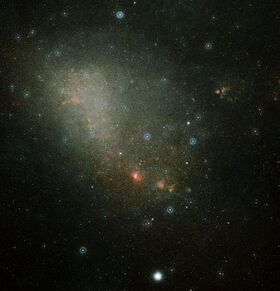Astronomy:SMC 018136
From HandWiki
Short description: Star in the Small Magellanic Cloud in the constellation Tucana
| Observation data Equinox J2000.0]] (ICRS) | |
|---|---|
| Constellation | Tucana |
| Right ascension | 0h 50m 56.095s[1] |
| Declination | -73° 44m 53.93s[1] |
| Apparent magnitude (V) | 11.61[2] |
| Characteristics | |
| Spectral type | K4.5 Ia-Ib,[3] M0Ia[4] |
| Apparent magnitude (K) | 7.849±0.020[1] |
| Astrometry | |
| Radial velocity (Rv) | 185.7[5] km/s |
| Details | |
| Radius | 945[6] R☉ |
| Luminosity | 186,000[6] L☉ |
| Surface gravity (log g) | −0.4[7] cgs |
| Temperature | 3,900[6] K |
| Other designations | |
| Database references | |
| SIMBAD | data |
SMC 018136, also known as PMMR 37, is a red supergiant star located in the Small Magellanic Cloud. It is one of the largest stars and one of the most luminous SMC cool supergiants so far discovered, with a radius of 945 times that of the sun and a bolometric luminosity almost 200,000 times more than Sun. If it were in the place of the Sun, its photosphere would at least engulf the orbit of Mars.[6]
SMC 018136 has a spectral type M0 Ia[4] and an effective temperature 3,900 K,[6] although more recent papers suggest it has a slightly earlier spectral type of K4.5 Ia-Ib.[3]
See also
References
- ↑ 1.0 1.1 1.2 "2MASS". Centre de Données astronomiques de Strasbourg. http://vizier.u-strasbg.fr/viz-bin/VizieR-S?2MASS%20J00505609-7215060.
- ↑ Høg, E.; Fabricius, C.; Makarov, V. V.; Urban, S.; Corbin, T.; Wycoff, G.; Bastian, U.; Schwekendiek, P. et al. (2000). "The Tycho-2 catalogue of the 2.5 million brightest stars". Astronomy and Astrophysics 355: L27. Bibcode: 2000A&A...355L..27H.
- ↑ 3.0 3.1 Davies, Ben; Crowther, Paul A.; Beasor, Emma R. (2018). "The luminosities of cool supergiants in the Magellanic Clouds, and the Humphreys–Davidson limit revisited". Monthly Notices of the Royal Astronomical Society 478 (3): 3138–3148. doi:10.1093/mnras/sty1302. Bibcode: 2018MNRAS.478.3138D.
- ↑ 4.0 4.1 Humphreys, R. M. (1979). "M supergiants and the low metal abundances in the Small Magellanic Cloud". Astrophysical Journal 231: 384. doi:10.1086/157201. Bibcode: 1979ApJ...231..384H.
- ↑ González-Fernández, Carlos; Dorda, Ricardo; Negueruela, Ignacio; Marco, Amparo (2015). "A new survey of cool supergiants in the Magellanic Clouds". Astronomy & Astrophysics 578: A3. doi:10.1051/0004-6361/201425362. Bibcode: 2015A&A...578A...3G.
- ↑ 6.0 6.1 6.2 6.3 6.4 Massey, Philip; Neugent, Kathryn F.; Ekström, Sylvia; Georgy, Cyril; Meynet, Georges (2023-01-01). "The Time-averaged Mass-loss Rates of Red Supergiants as Revealed by Their Luminosity Functions in M31 and M33". The Astrophysical Journal 942 (2): 69. doi:10.3847/1538-4357/aca665. ISSN 0004-637X. Bibcode: 2023ApJ...942...69M.
- ↑ Dicenzo, Brooke; Levesque, Emily M. (2019). "Atomic Absorption Line Diagnostics for the Physical Properties of Red Supergiants". The Astronomical Journal 157 (4): 167. doi:10.3847/1538-3881/ab01cb. Bibcode: 2019AJ....157..167D.
 |


